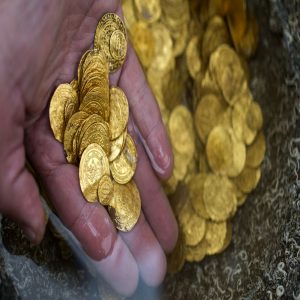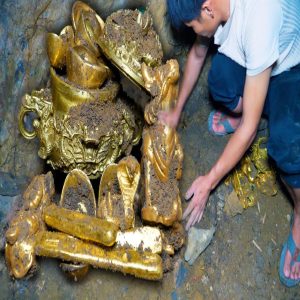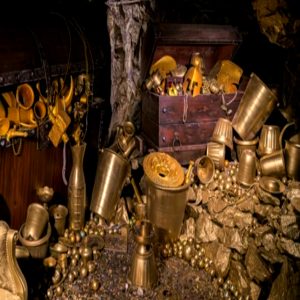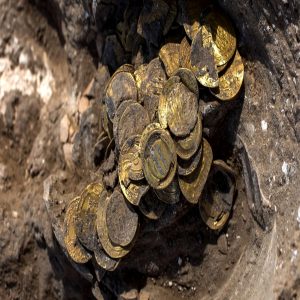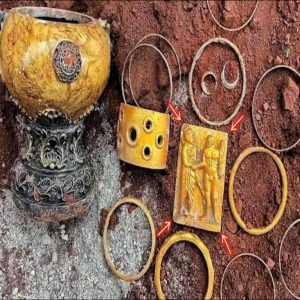A metal detecting enthusiast has found a rare gold ring, which may reveal a new, unknown princely family in Denmark, which had close connections to the European great power of the time. The ring was found in the same area as a set of golden horns, where an unknown elite may have ruled for hundreds of years, archaeologists believe.
The gold ring is set with a red semi-precious stone and constructed with well-executed spirals on the underside and trefoil knobs in the transition between the ring rail and the socket with the stone – a style characteristic of Frankish craftsmanship.

Metal detectorist, Lars Nielsen was the finder of the ring last year. (Private photo/ The National Museum Denmark)
Find of A Lifetime Reveals Unknown History
When 39-year-old Lars Nielsen dug a large gold ring set with a red semi-precious stone out of the ground in Emmerlev in Southwest Jutland one spring day, he knew he had made the find of a lifetime. Still, the piece of jewelry was hiding a story that is far greater than he had imagined.
“I was so excited and overwhelmed that I could hardly say anything, and that’s not usually something that characterizes me, but it is without a doubt my best find so far. To make such a unique and one-of-a-kind find is completely surreal. I am very proud and honored to be able to contribute a piece to our shared history both locally and nationally,” said Mr Nielsen.
Because the gold ring probably reveals the presence of a new, unknown princely family in the area with close connections to the Merovingians – a royal family that ruled the Kingdom of France, which at this time was a great power in Europe, covering large parts of today’s France, Belgium and Germany.
This is due to the gold ring’s special construction, which is known from rings worn by the Merovingian elite, explains Kirstine Pommergaard, who is a museum inspector at the National Museum and made the discovery when she studied the piece closely.
“The gold ring not only reveals a possible new princely family in Emmerlev, but also connects the area with one of Europe’s largest centers of power in the Iron Age. The gold ring is probably a woman’s ring and may have belonged to a prince’s daughter who was married to a prince in Emmerlev. Gold is typically a diplomatic gift, and we know that people have married into alliances, just as it probably happened with Thyra and Gorm the Old and in more recent times when Christian the 9th became known as ‘Europe’s father-in-law’ for marrying his daughters into other royal houses,” she said.

The ring has a distinct craftmanship, linked to the Merovingian elite. (The National Museum Denmark)
Something About the Music
The gold ring has been handed over to the National Museum by Museum Sønderjylland, and there is great excitement over the historical significance of the find for the Wadden Sea region.
“We’ve never seen anything like it out here. Many discoveries have been made over time that point to global trade connections at the Wadden Sea. The gold ring substantiates that there has also been an elite who have had something to do with music. Not everyone has had contact with the Merovingians,” says Anders Hartvig, museum inspector at Museum Sønderjylland.
Kirstine Pommergaard adds:
“The Merovingians were interested in entering into a network with families and individuals who could control trade and resources in an area. “Perhaps the princely family in Emmerlev had control over an area between Ribe and Hedeby and thus secured trade in the area,” she says.

The ring exhibits Merovingian construction traits. (The National Museum Denmark)
Unique Craftsmanship
The connection to the Merovingians is due to the ring’s construction with very well-executed spirals on the underside and trefoil knobs in the transition between the ring rail and the socket with the stone, which is characteristic and well known for Frankish craftsmanship.
“It is an impressive level of craftsmanship that is difficult to imitate today,” says Kirstine Pommergaard.
The archaeologists do not believe that the ring was simply lost during a trading trip for two main reasons. First, other objects have been found in the same area – notably two gold coins, seven silver coins (sceattas) and Frisian turned pottery – which confirm contact with the Merovingian area, probably via allies in Friesland, which was located in present-day Belgium and the Netherlands.
Secondly, the ring is set with a red semi-precious stone, which is a well-known symbol of power in the Nordics, while the elite gold rings of the Merovingians are typically set with a coin or a plaque, like a signet ring. This shows that the ring was to serve as a symbol of power in the Nordics.
Local Power Elite for Centuries
The gold ring from the 5th-6th centuries was found just 10 kilometers (6 miles) from the site of the Golden Horns of Gallehus (from the 4th century) and two kilometers (1.3 miles) from the ring rampart Trælbanken (from the first century), which may still have been in operation at the time of the gold ring. The many large finds in the area paint a picture of a power elite that has ruled the area for hundreds of years, Anders Hartvig believes.
“The person who had the ring probably also knew about the people who had the golden horns. Maybe they were related. Together with other recent finds, it paints a picture that Southern Jutland has had a greater influence than previously thought, and that the Wadden Sea was not closed in on itself, but had an aristocratic presence with important trade links to the south,” says Anders Hartvig.
It is precisely the local history of Denmark that Lars Nielsen thinks is the most interesting aspect of the ring, of which he has had a replica created and given to his wife as a Christmas present.
“Hopefully, it will be passed down in the family, who will in future be able to identify where it was found and present the letter from the National Museum, which describes the ring’s special history and significance. So in that way it has been perpetuated in our family,” he says.

